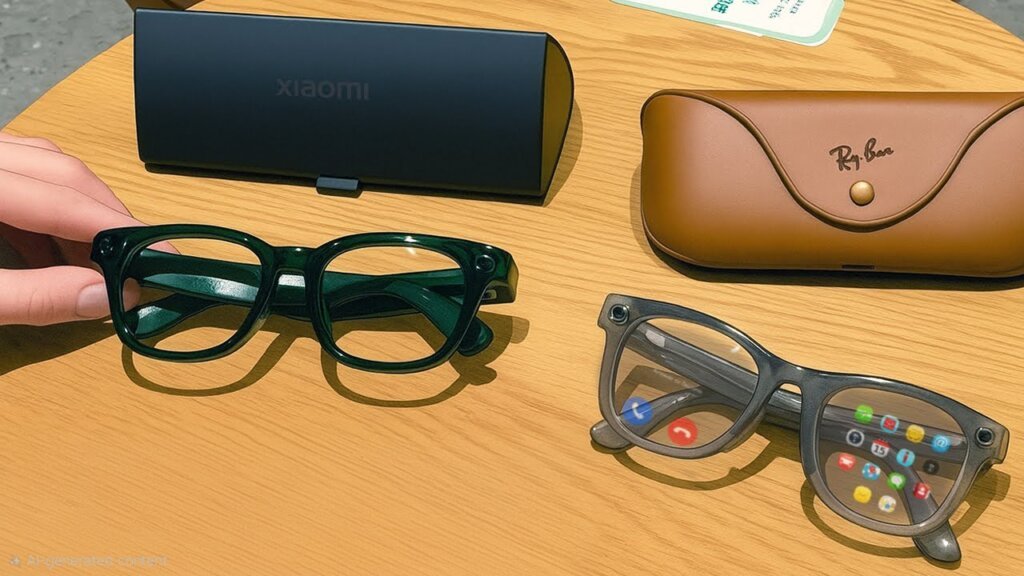What if your eyewear could do more than just help you see? Imagine glasses that translate conversations in real-time or record high-quality video, all while looking stylish. Enter the world of smart glasses, where two major players, Xiaomi and Ray-Ban Meta, have taken radically different approaches. Xiaomi’s AI Smart Glasses lean heavily into tech-forward functionality, while Ray-Ban’s Meta Glasses blend iconic style with social convenience. This isn’t just about glasses; it’s a statement on how we want technology to fit into our lives.

The Verdict Up Front
Choose Xiaomi AI Smart Glasses if…
You are a tech enthusiast who prioritizes advanced, practical features like real-time translation, versatile electrochromic lenses, and a long-lasting battery for intensive tasks.
Choose Ray-Ban Meta Glasses if…
You value iconic style and social convenience. You want a simple, fashionable way to capture quick moments, take calls, and listen to music without looking like you’re wearing bulky tech.
AI Smart Glasses Showdown
| Feature | Xiaomi AI Smart Glasses | Ray-Ban Meta Glasses |
|---|---|---|
| Aesthetic | Tech-Forward, Minimalist | Iconic Wayfarer & Skyler |
| Main Camera | 12MP Ultrawide | 12MP Ultrawide |
| Video Quality | 2K @ 30fps | 1440×1920 @ 30fps |
| Video Limit | 45 minutes continuous | 3 minutes per clip |
| Battery Life | ~8.6 hours | ~4 hours (plus case) |
| Lenses | Electrochromic (Clear to Tinted) | Standard or Transition Lenses |
| Core AI | Multifunctional (Translate, Scan) | Social & Media (Meta AI) |
| Audio | Privacy-focused (Bone Conduction) | Clarity-focused (Enhanced Bass) | }
| Price | ~$280 – $420 (China-only) | ~$299 – $379 (Global) |
Key Stats Comparison
Battery Life (Hours)
Video Quality (Max)
Weight (Grams)
Lenses: Versatility vs. Simplicity
The lenses highlight their differing priorities. Xiaomi’s electrochromic lenses provide adaptability by allowing users to switch between transparent and shaded modes with a single touch. This feature ensures comfort in various lighting conditions and supports prescription lenses, making them highly practical.
Ray-Ban, however, opts for a more streamlined approach. Users can choose between standard sunglass lenses or transition lenses that automatically adjust to light. While this offers less customization, it prioritizes convenience and preserves the brand’s iconic aesthetic.
Battery Life: Endurance vs. Convenience
Battery performance underscores the distinct use cases. Xiaomi offers up to 8.6 hours of regular use, with the ability to record 2K video continuously for 45 minutes. This extended battery life supports its feature-rich design, catering to users who require prolonged, intensive functionality.
Ray-Ban provides approximately 4 hours of usage, extendable with a charging case. While shorter, this battery life aligns with its focus on casual, social interactions rather than extended, feature-heavy use.
Cameras: Content Creation vs. Social Sharing
Both glasses feature 12MP ultrawide cameras, but their applications differ. Xiaomi supports high-quality content creation, offering 45 minutes of 2K video recording and live streaming. These features are ideal for users who prioritize professional-grade recording.
Ray-Ban’s cameras are tailored for quick, social sharing. They record high-resolution vertical video for up to 3 minutes, perfect for capturing spontaneous, short moments for social media.
AI Features: Comprehensive Tools vs. Everyday Simplicity
Xiaomi’s AI capabilities are extensive, offering tools like real-time translation in over 10 languages, object recognition, calorie scanning, and meeting summaries. This caters to users seeking a multifunctional, tech-heavy experience.
Ray-Ban, by contrast, integrates Meta AI for messaging, calls, music control, and social media sharing. Its translation is more limited, reflecting its focus on enhancing daily interactions rather as a broad suite of AI tools.
Design: Minimalism vs. Timeless Style
The design philosophies further highlight their differences. Xiaomi’s lightweight frames (40g) are optimized for comfort and practicality. Ray-Ban, on the other hand, stays true to its roots with classic Wayfarer and Skyler styles, weighing slightly more (49-51g) but blending traditional aesthetics with modern technology.
Pricing and The Final Choice
Xiaomi’s glasses are priced between $280 and $420, but their availability outside China remains limited, making them a niche product for now. Ray-Ban’s models range from $299 to $379 and are widely available globally, appealing to a broader demographic.
Ultimately, the decision comes down to what you value most. If you prioritize innovative technology and a feature-rich design, Xiaomi offers a strong option. If you prefer a polished, familiar design with a focus on social convenience, Ray-Ban provides a more accessible and stylish alternative.




